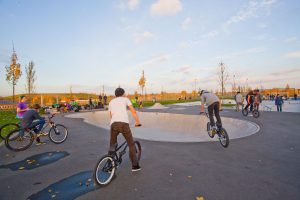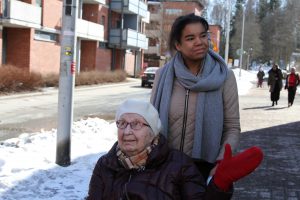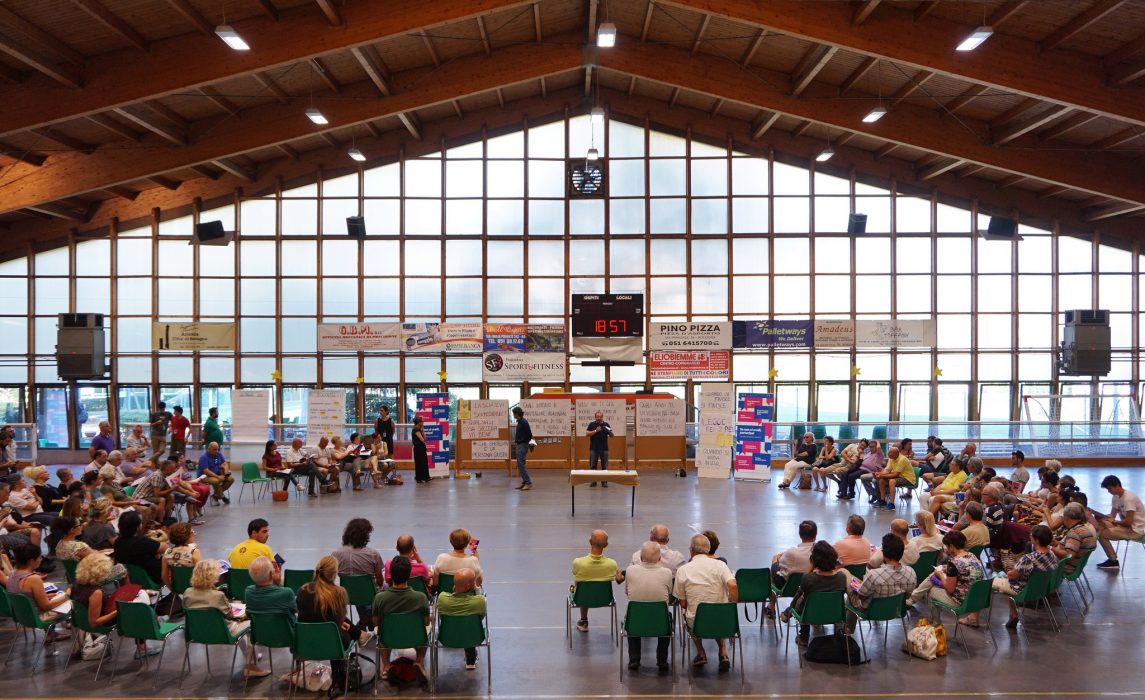This article originally appeared in Fast Company.
By taking a more personal approach, the international finalists for Cities of Service’s Engaged Cities Award are fostering engaged and empowered citizenries.
As more people migrate to urban areas, today’s cities face the challenge of how best to serve a growing population. Certainly, state-of-the-art data tools can give them a keen understanding of the greatest needs and problems, but another element is just as critical: an engaged citizenry.
That’s one of the fundamental beliefs driving Cities of Service, a New York City-based nonprofit group that helps local governments and citizens work together better. The organization has attracted 240 U.S. and U.K. member cities since it was founded in 2009. In November 2017, Cities of Service furthered its commitment to this ideal by launching the Engaged Cities Award. Ten finalists—five American cities and five international cities—were announced in April, and later this month, a grand prize of $100,000 and two additional $50,000 prizes will be awarded to cities that have implemented innovative tactics for effectively engaging their residents.
Recently, we explored some exciting examples of U.S. cities thinking and acting like startups. As those finalists demonstrate, being innovative in an urban context doesn’t necessarily mean redefining the city. It means returning to a fundamental understanding of what a city should be—a community designed by and for citizens, each and every one of whom has a strong sense of belonging.
Internationally, this thinking is also very much alive, as embodied by the following finalist cities. Despite their seemingly disparate projects, they’re making progress by adopting a similar strategy: bringing a people-centered approach to these collaborations.
RESTORING PRIDE
Cities built primarily upon one industry possess a singular sense of pride that more diverse economies don’t typically share. But when a changing global economy pushes that industry to the sideline, factory closings and sector decline can rob these areas of their jobs and their spirit.
That was the problem facing Hamm, a city of 180,000 in northwestern Germany. The former mining center saw its last coal mine shut down in 2010. While other industries offered new job opportunities, generations of mine workers feared losing their collective identity. As the wall surrounding the old mine was demolished, onlookers wept as a marching band played “Glück auf, der Steiger kommt,” an old miners’ song.
Several conventional proposals for the area’s economic revitalization—business parks or a shopping mall—were considered, but the city opted for an unconventional option. It would transform the former mining land into a beautiful new park that would be a haven for socializing and recreation.
“The state government was looking for an area to carry out a big garden exposition,” says Heinz-Martin Muhle, Hamm’s head of urban planning. “We applied with this area, but another city was rewarded with the contract. But the state government was still enthusiastic about our concept, and we got special financial support. That allowed us to plan it exactly as we wanted—it was a stroke of luck for us.”

The objective in planning the park, called the Lippepark, was to create a space that appealed to the broadest possible population, and was a collaborative effort. Hamm assembled a citizen’s council, including representatives from local civic societies, religious groups, sports clubs, and artists’ collectives. The diversity of thought yielded a diversity of ideas for the park: a parkour course, a multi-denominational worship space, and a variety of sculptures, to name a few. One exhibit paying tribute to Hamm’s coal mining history stands out to Muhle as representative of the entire undertaking’s goal.
“The mine created and changed the entire district. It was a nucleus of the villages,” he says. “Only with the knowledge of our history is it possible to build our future.”
Now, Muhle says, people who had never set foot in Hamm travel from over 30 miles outside the region to use the park’s facilities. When the first section of the park opened in December 2012, a marching band played “Glück auf, der Steiger kommt” once again—but this time, the crowd was joyful.
By establishing a citizen’s council to shape the Lippepark, Hamm gave its residents a personal stake in their city’s future. The concept of sourcing and incorporating a wide range of ideas and input has many applications for cities, in development, government, and other areas.
POWER TO THE PEOPLE
After decades of political volatility in Mexico, the last two decades have offered relative stability to its citizens. When Mexico City, one of the most populous urban areas in the world, announced in 2016 that it would establish a local constitution, the city took another step forward in ensuring its citizens’ rights. Rather than relying solely on public officials, the city—and the mayor in particular—wanted citizens at the table, helping define what it means to be a Mexico City citizen. Their involvement in creating the city’s first constitution would foster a sense of ownership in the constitution.
“There was tension in terms of, who is going to draft this constitution?” says Gabriella Gómez-Mont, founder of the multidisciplinary Mexico City governmental think tank Laboratorio para la Ciudad. “How is it going to happen? How is it going to represent the voices of the people?”

The city took a multi-tiered approach to incorporating citizen voices into the drafting the constitution. First, a group of 28 well-known Mexico City residents from throughout the city formed to propose ideas. This team included retired politicians, artists, and activists, including Carlos Cruz, an ex-gang member turned community leader. The city was adamant about citizen participation. It sought out their voices while working to overcome any of their skepticism toward the project.
“The mayor also knocked on my door and said, ‘You know, we also need to have a younger generation and the population at large being able to give their input into how they feel,’” Gómez-Mont says. “We designed a whole digital platform.”
The platform educated citizens on the process of creating the constitution. They expressed concerns about the city through a survey. It also offered them the opportunity to introduce petitions to help shape the constitution. Over the course of several months, nearly 280,000 people signed on to 357 different petitions, and those that received enough citizen support on the platform would be incorporated directly into the governing document. When the constitution was formally approved in early 2017, a good number of citizen-drafted initiatives were included.
“The petition makers, most of them didn’t actually have prior experience in social organizing,” said Gómez-Mont. “One of them is 17 years old, and now his ideas are in the constitution.”
City governments will always hear from their most vocal citizens, but by proactively seeking out and incorporating previously unheard voices, Mexico City gained valuable new insights on how its government could work best for everyone. The same is true in Helsinki, where the city is actively empowering immigrant youths through education—and the learning goes both ways.
REACHING OUT TO THE MARGINALIZED
Immigrants make up 14.3% of Helsinki’s population—a number expected to rise to 23% by 2030. Today, roughly a quarter of its young immigrants are neither employed nor participating in education or job training. It’s an issue that the city decided to address so that its immigrant citizens—and its population as a whole—will flourish.
Migrant Youth Helsinki, the city’s newly formed group for outreach (Helsinki refers to its immigrants as migrants), didn’t immediately try to develop corrective measures. Instead, it spent a year listening intently to its migrant communities to learn what needed to be fixed, and how.
“I think the key finding from the very first discussions was that there wasn’t a lack of motivation in terms of integrating into the society, learning the skills, and learning the language,” says Tommi Laitio, Helsinki’s executive director of culture and leisure. “Migrant youths often felt that they were targets for interventions planned by others, where they were just on the receiving end. They wanted to be seen as active contributors to society.”
Once Migrant Youth Helsinki had an in-depth understanding of the demographic’s challenges, the group partnered with the teens themselves to create a series of initiatives to activate them as agents of civic good. This collaborative design process—which also included parents and teachers from immigrant communities—allowed youths to build programs that worked best for them.

One initiative, known as Buddyschool, assigns immigrant teens as tutors for younger immigrant students. The pairings have improved the grades of both groups, given the kids a sense of purpose, and strengthened the community.
Another program, Job’d, brings together young immigrants with another marginalized community: the elderly. Using an app designed by a Finnish tech startup, Job’d connects the young immigrants to paid tasks they can perform in the community, many of which involve doing housework or grocery shopping for senior citizens. Through ratings on the app, the teens are able to build a positive reputation that they can leverage to find further employment.
“We’ve managed to combine these two issues so that some of the tasks have been that young people take the older people to community events, so that we don’t hide our old people into care homes, but actually give them a chance to be a part of the community,” Laitio says.
As in Hamm and Mexico City, Helsinki leaders made a difference by finding ways to work with people one-on-one. These investments of time and energy have given citizens a newfound sense of belonging in their communities and a greater sense of trust in local leaders. Not surprisingly, the residents are more inclined to contribute ideas and insight to improve their cities. The stories provide further proof that for cities today, perhaps there’s no resource more valuable than the thoughtful, creative suggestions and community participation of its citizens.
This story was created for and commissioned by Cities of Service.

